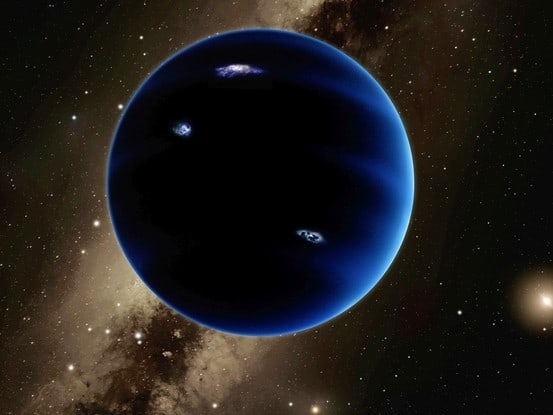
 Planet Nine exists.
Planet Nine exists.
That seems to be the growing consensus from the astronomical community, as more and more evidence is uncovered indicating a ninth planet out in the far reaches of the solar system, orbiting in the darkness and waiting ever so patiently to be discovered.
New research from the University of Arizona has focused on the orbital paths of a group of six identified space objects orbiting in the region of the solar system beyond Neptune known as the Kuiper Belt. These “extreme Kuiper Belt Objects” have long elliptical orbits which bring them at times close to the Sun and then off into the far netherworld – sometimes hundreds of Astronomical Units away (one AU represents the distance between the Earth and the Sun). In studying these extreme KBOs, the Arizona team found that the best explanation for their strange orbits is the likely presence of another large body whose gravitational force is influencing their paths.
There is a ninth planet in our solar system…
“We analyzed the data of these most distant Kuiper Belt Objects,” says Renu Malhotra, Regents’ Professor of Planetary Sciences with the University of Arizona’s Lunar and Planetary Laboratory in Tucson, Arizona, “and we noticed something peculiar, suggesting they were in some kind of resonances with an unseen planet.”
Based on their calculations, the researchers say the so-called Planet Nine would be about ten times the size of Earth and have an orbital path that takes it a whopping 660 AUs from the Sun. And, important for trying to locate the elusive object in the night sky, the new study suggests two likely orbital planes for Planet Nine, one at about 18 degrees from the ecliptic plane and the other at 48 degrees. (The ecliptic plane describes that two-dimensional surface of the Earth’s elliptical orbit around the Sun, which happens to also be, roughly, the same plane on which all the known planets travel.)
The strange tilt of these Kuiper Belt objects has been the focus of investigation for some time, with astrophysicists Konstantin Batygin and Michael Brown at the California Institute of Technology earlier this year positing the existence of a ninth planet from the orbits of KBOs and estimating an inclination of 30 degrees from the ecliptic.
And so, you may ask, why is it that with a whole crew of scientists now training their scopes along the same angles of the night sky -including Canadians such as Cory Shankman at the University of Victoria and Samantha Lawler of the National Reserach Council, whose work concentrates on orbital distributions of KBOs -with all of these scientists looking out for the same, supposedly pretty massive object, then, why have we yet to find number nine?
The reality is that the expanse of sky that needs to be explored with a fine-toothed telescope is vast -consider the moon’s face as one unit of area and times that by 3,000 and you have an idea of how much sky is available for Planet Nine.
Which is why further research can only help to narrow down the searching grounds and why knowing more about the disparate objects that make up the Kuiper Belt will help get us closer to finding planet number Nine. Astronomer Scott Sheppard of the Carnegie Institution for Science, says, “Right now we are dealing with very low-number statistics, so we don’t really understand what is happening in the outer Solar System. Greater numbers of extreme trans-Neptunian objects must be found to fully determine the structure of our outer Solar System.”
Just last century, of course, we already had nine planets to the solar system, counting Pluto. First discovered in 1930, Pluto enjoyed planetary status for a good seven decades, only to be summarily demoted to dwarf planet status and dumped into the Kuiper Belt group of objects by the International Astronomical Union in September, 2006.
Below: Planet X: Scientists Find Evidence for 9th Planet In Our Solar System
Comment
Leave a Reply
You must be logged in to post a comment.




 Share
Share Tweet
Tweet Share
Share




you guys misspelled the city of Tucson in your article. you spelled it tuscon!
We have had the complete set of orbital parameter for a large planet in a 4969 year orbit for some time now. Its orbital inclination seems very close to the anticipated 48 degrees. We cal it Vulcan because we followed Madam Blavatsky’s suggestions on how to find it and she called it Vulcan. Here is a link to its orbital parameters, Forbes almost found it in 1880.
http://www.barry.warmkessel.com/vulcanrevealed.html#2
Table 2
Vulcan’s Orbital Parameters
Parameter Value Max. Error Min. 2 Sigma Error Forbes'(1880)*
Orbital Inclination 48.44o +3.12o/-9.05o +/- 0.23o 45o